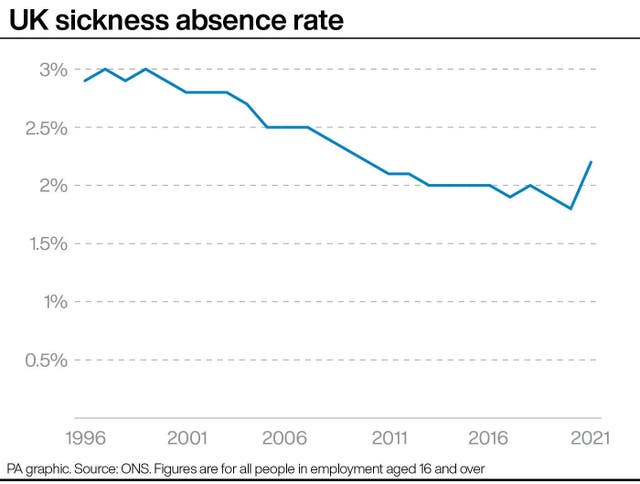
Shelagh Fogarty 1pm - 4pm
29 April 2022, 12:04

The most common reason for sickness absence included accidents, poisonings, diabetes and coronavirus, says the ONS.
Sickness absence increased last year following the end of the furlough scheme, new Covid variants and the decline in homeworking, official figures show.
The sickness absence rate rose to 2.2%, from a record low of 1.8% in 2020 – the highest since 2010, when it was also 2.2%.
An estimated 149.3 million working days were lost because of sickness or injury last year, equivalent to 4.6 days per worker, said the Office for National Statistics (ONS).
The most common reason for sickness absence included accidents, poisonings, diabetes and coronavirus.

The ONS reported a record low absence rate in 2020, with Covid measures such as furloughing, social distancing, shielding and increased homeworking helping to reduce other causes of absence.
Covid-19 accounted for nearly one in four of all sickness absence in 2021, up from 13.9% in 2020.
The groups with the highest rates included women, older workers, those with long-term health conditions, part-timers and people working in caring, leisure and other service occupations.
The relaxation of coronavirus restrictions during periods of 2021 and less requirement to work from home, may have contributed to an increase in sickness absence in 2021, said the ONS.
The report added that the sickness absence rate generally declined through the 2000s and has remained relatively flat throughout the 2010s, dropping to a record low in 2020.
In 2021, as in previous years, workers living in Wales had the highest sickness absence rate (2.8%), while those in London had the lowest (1.7%).
The report said this can be largely explained by the younger age profile of people and workers living in London and the types of jobs they have.
Tina McKenzie from the Federation of Small Businesses said: “The average cost of sickness absence, including finding cover, stands at more than £3,000 a year for small employers, equating to £5 billion across the small business community as a whole.”
She said that, with operating costs “surging”, small firms “need more financial assistance to go on doing right by their staff when they’re unwell.”
She added: “On the day that the Government has announced yet more help for big energy intensive companies, we’re asking policymakers to take forward our joint proposal with the TUC for a small business sick pay rebate which will help those who have received no help whatsoever with utility bills.
“Allowing small community businesses to recover sick pay costs will give them that much more space to invest, recruit and retain staff, spurring our economic recovery from the grass roots up.”